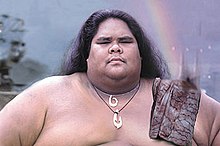Israel Kamakawiwo'ole
| Israel "Iz" Kamakawiwoʻole | |
|---|---|

Israel in 1993
|
|
| Background information | |
| Birth name | Israel Kaʻanoʻi Kamakawiwoʻole |
| Born |
May 20, 1959 Honolulu, Territory of Hawaii |
| Origin | Hawaii, United States |
| Died | June 26, 1997 (aged 38) Honolulu, Hawaii, U.S. |
| Genres | |
| Occupation(s) |
|
| Instruments |
|
| Years active | 1976–1997 |
| Labels | |
| Associated acts | Makaha Sons of Niʻihau |
| Notable instruments | |
| Ukulele | |
Israel "Iz" Kaʻanoʻi Kamakawiwoʻole (Hawaiian pronunciation: [kəˌmɐkəˌvivoˈʔole]) translation: "The Fearless Eyed"; May 20, 1959 – June 26, 1997), also called Bruddah Iz (Brother Iz), was a Hawaiian musician, entertainer and Hawaiian sovereignty activist.
His voice became famous outside Hawaii when his album Facing Future was released in 1993. His medley of "Somewhere over the Rainbow/What a Wonderful World" was subsequently featured in several films, television programs, and television commercials.
Along with his ukulele playing and incorporation of other genres, such as jazz and reggae, Kamakawiwoʻole remains influential on Hawaiian music.
Kamakawiwoʻole was born at Kuakini Hospital in Honolulu to Henry "Hank" Kaleialoha Naniwa Kamakawiwoʻole, Jr. and Evangeline "Angie" Leinani Kamakawiwoʻole. The notable Hawaiian musician Moe Keale was his uncle and a major musical influence. He was raised in the community of Kaimuki, where his parents had met and married. He began playing music with his older brother Skippy and cousin Allen Thornton at the age of 11, being exposed to the music of Hawaiian entertainers of the time such as Peter Moon, Palani Vaughn and Don Ho, who frequented the establishment where Kamakawiwoʻole's parents worked. Hawaiian musician Del Beazley spoke of the first time he heard Israel perform, when, while playing for a graduation party, the whole room fell silent on hearing him sing. Israel continued his path as his brother Skippy entered the Army in 1971 and cousin Allen parted ways in 1976 for the mainland.
In his early teens, he studied at Upward Bound (UB) of the University of Hawaii at Hilo and his family moved to Mākaha. There he met Louis "Moon" Kauakahi, Sam Gray and Jerome Koko. Together with his brother Skippy they formed the Makaha Sons of Niʻihau. A part of the Hawaiian Renaissance, the band's blend of contemporary and traditional styles gained in popularity as they toured Hawaii and the continental United States, releasing fifteen successful albums. Kamakawiwo'ole's aim was to make music that stayed true to the typical sound of traditional Hawaiian music. During that time period, the songs that many people associated with Hawaii, typically, were not traditional-sounding songs.
...
Wikipedia
